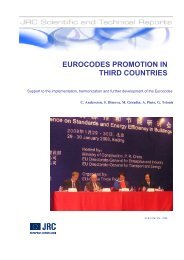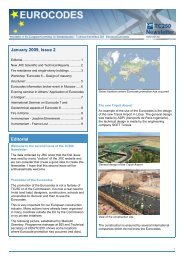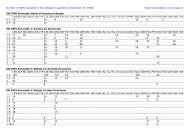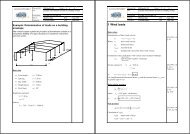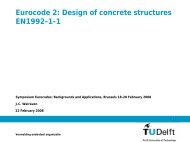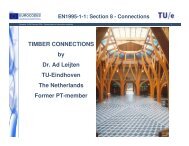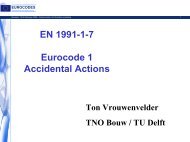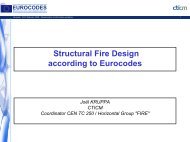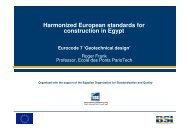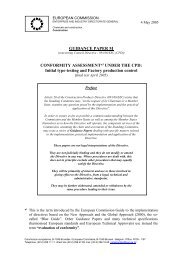aluminium structures fatigue design – concepts and tools - Eurocodes
aluminium structures fatigue design – concepts and tools - Eurocodes
aluminium structures fatigue design – concepts and tools - Eurocodes
You also want an ePaper? Increase the reach of your titles
YUMPU automatically turns print PDFs into web optimized ePapers that Google loves.
Kosteas <strong>–</strong> AlFat EC9 Brussels 20 Feb 2008 1 - 8ALUMINIUM STRUCTURESFATIGUE DESIGN <strong>–</strong> CONCEPTS AND TOOLSUniv. Prof. Dr.-Ing. Dr.-Ing. habil. Dimitris KosteasProf. Onor. TUPT(RO), FellTWI, FASCESection Light Metal Structures & Fatigue, Inst. for Building Materials & ConstructionTechnische Universität München, Arcis St 21, D-80333 Munich, Germany, kosteas@lrz.tum.deThe recently compiled European Codes for <strong>design</strong> <strong>and</strong> execution in <strong>aluminium</strong> <strong>structures</strong> are presented <strong>and</strong>discussed. Within the framework of material characteristics, consequences of failure <strong>and</strong> execution classes forstructural components <strong>design</strong> principles <strong>and</strong> <strong>concepts</strong> for parts <strong>and</strong> their joints of the comprehensive <strong>and</strong> inseveral aspects innovative approach to <strong>fatigue</strong> <strong>design</strong> rules of EN 1999-1-3 is discussed. The followingintroductory text is accompanied by a series of figures illuminating characteristic procedures <strong>–</strong> links to thesefigures are mentioned where necessary in the text.Specifications for the <strong>design</strong> <strong>and</strong> execution of <strong>structures</strong> will follow certain universal <strong>concepts</strong>of safety <strong>and</strong> reliability, as well as <strong>design</strong> principles <strong>and</strong> methods, irrespective of the specificfield of application. The area of application of <strong>Eurocodes</strong> for the <strong>design</strong> of <strong>aluminium</strong><strong>structures</strong> is the “<strong>design</strong> of buildings” as well as “structural engineering works” covering - bymerit of the supporting experimental data background <strong>–</strong> related fields of application liketransportation, e.g. marine <strong>structures</strong>, rail-bound vehicles, etc. Eurocode 9: EN 1999-1 on<strong>design</strong> <strong>and</strong> EN 1090-3 on execution provide to the engineering community a comprehensivetool to deal with a variety of structural shapes, joints, <strong>and</strong> loading cases. The presentationindicates also differences in material characteristics between aluminum <strong>and</strong> steel leading todifferent procedures in respective codes <strong>and</strong> outlines several innovative approaches that havebeen integrated in the aluminum <strong>design</strong> code.STRUCTURAL INTEGRITY CONCEPTThe <strong>design</strong> of <strong>aluminium</strong> <strong>structures</strong> is in accordance with the general rules in EN 1990 settingthe principles for characteristic <strong>and</strong> <strong>design</strong> values for actions <strong>and</strong> resistance, <strong>and</strong> respectivepartial safety factors within the reliability framework, Fig. 3. The reliability management for<strong>design</strong> <strong>and</strong> execution work according to EN 1990: Basis of structural <strong>design</strong> <strong>–</strong> Annex Bintroduces a classification system with subsequent requirements to execution <strong>and</strong> inspectionof work, which is adjusted to the importance of the structure with the intention to optimizecosts in providing for a safe <strong>and</strong> reliable structure. The consequences of structural failure arethe main classification feature, Fig. 4 to 6.The selection of the execution class is also influenced by the stress situation <strong>and</strong> the <strong>design</strong>criteria, <strong>and</strong> defines the necessary requirements for execution work. The latter are influencedby the testing method <strong>and</strong> the extent of inspection, as well as the structural detail <strong>and</strong> the
Kosteas <strong>–</strong> AlFat EC9 Brussels 20 Feb 2008 2 - 8limits of its imperfections or the quality level QL, as defined for instance in EN ISO 10042for welded details. The execution class may apply to the whole or a part of the structure, toone or more components or to specific details. It is a condition for <strong>aluminium</strong> <strong>structures</strong> thattheir execution shall follow the rules given in EN 1090-3. The execution class should bedefined in the project specification.GENERAL DESIGNThe new Eurocode 9 for <strong>design</strong> of parts presents a broad range of wrought <strong>and</strong> cast alloys forstructural components, along with characteristic values for the material properties, <strong>and</strong> forconnecting devices (bolts, rivets) in both <strong>aluminium</strong> <strong>and</strong> steel. Respective information isincluded, in detail especially for welded joints, <strong>and</strong> adhesively bonded joints. This alloy listmay have to be adapted for applications in shipbuilding <strong>and</strong> specific alloys should becontrolled in respect to durability requirements or when in contact with other materialsrecommendations in EN 1999-1-1 Annex D <strong>and</strong> EN 1090-3 should be observed. Rules for<strong>fatigue</strong> <strong>design</strong> in EN 1999-1-3 cover all the above options.FATIGUE DESIGNThe elaboration of <strong>fatigue</strong> <strong>design</strong> rules for <strong>aluminium</strong> <strong>structures</strong> has been a comprehensivetask on national <strong>and</strong> especially European level in the last 25 years. The basis for the draftingprocedure has been a comprehensive <strong>and</strong> reliable data bank, including a significant amount offull-size component tests, Fig. 8. Ensuing multiple data analyses <strong>and</strong> evaluation workshopsrefined the statistical input parameters, thus allowing for the fulfilment of basic safety <strong>and</strong>reliability rules on the one h<strong>and</strong>, but also for practicable engineering solutions on the other. Arepresentative compilation of results has been published which together with an earlier outlineof the code draft provide links to numerous background references.THE CODE FORMATRepeated discussions within the drafting body, not only on issues of experimental datainterpretation, but also on the overall format of the code, the importance <strong>and</strong> extent of analysis<strong>and</strong> verification methods, the inclusion of specific structural details <strong>and</strong> joining methods, evenon details of visual presentation, manifest the special significance that <strong>fatigue</strong> <strong>design</strong> has forlight-weight <strong>aluminium</strong> <strong>structures</strong> under repeated loading - at a lower ratio of dead to liveload.A general adaptation to the format of respective codes for steel <strong>structures</strong> has beenundertaken, although differences do persist. As a consequence of the sound data basis withlarge components <strong>and</strong> their comprehensive statistical analysis, both for conventional stress vs.life as well as for crack propagation vs. stress intensity relationships, the Eurocode for<strong>aluminium</strong> was first to introduce some new issues or changes over earlier codes.Three separate <strong>fatigue</strong> <strong>design</strong> procedures are distinguished:a) Traditional safe-life <strong>design</strong>, based on evaluation of S-N curvesb) Damage tolerant <strong>design</strong>, <strong>and</strong>c) Design assisted by testing.
Kosteas <strong>–</strong> AlFat EC9 Brussels 20 Feb 2008 3 - 8In safe-life <strong>design</strong> it was decided to group the different structural details in three slope valuegroups (m=7 or 4,3 or 3,4 in the main cycle range from 10 5 to 5⋅10 6 cycles), the first coveringpractically parent material, the other two all welded details. Together with assuming a highercycle range as the reference point for estimation of <strong>design</strong> S-N curves this approach allows fora closer fit to actual test data in the cycle range of primary interest for <strong>aluminium</strong> applications<strong>and</strong> thus more economical <strong>design</strong>. The mean stress effect was also taken into account in<strong>design</strong> by introducing a bonus factor, Fig. 10.Rules for <strong>aluminium</strong> in damage tolerant <strong>design</strong> bear in our view a clearly formulated concept<strong>and</strong> procedure. The method is introduced as a complementary <strong>design</strong> option to safe-life<strong>design</strong>, in case that the latter with the linear damage accumulation leads to values larger thanunity. Damage tolerant <strong>design</strong> is based on the estimation of crack propagation on the basis offracture mechanics criteria <strong>and</strong> procedures. Of special importance is the fact that in the case of<strong>aluminium</strong> complete information about the crack propagation behavior of the material <strong>and</strong> itswelded joints is available, allowing for respective quantitative establishment of inspectionintervals.In the following specific issues in the Eurocode for <strong>fatigue</strong> <strong>design</strong> are highlighted <strong>and</strong> furtherbackground data is provided.ESTABLISHMENT OF DESIGN S-N CURVESIn addition to the above mentioned points we may add that an equidistant mesh ofcharacteristic values for the <strong>design</strong> curves, i.e. the value Δσ C [N/mm²] at 2⋅10 6 cycles, hasbeen conceived, introducing a logical pattern in case of necessary reductions due to corrosionor thickness effects, Fig. 11.To demonstrate the situation during the data analysis of earlier small specimen data togetherwith large component test results from different laboratories <strong>and</strong> the life cycle range arepresentative diagram is given in Fig. 12 for the cruciform joint, i.e. transverse load-carryingfillet welds. Additional comparisons between <strong>design</strong> curve proposals in differentrecommendations were also performed.The format of the <strong>design</strong> curves is given in Fig. 13 for the main life cycle range between 10 5<strong>and</strong> 10 8 . The code defines also a <strong>design</strong> curve for the range between 10 3 <strong>and</strong> 10 5 , but only forsome alloys <strong>and</strong> R-ratios where test data has been available.Bearing in mind the current state of development of <strong>fatigue</strong> <strong>design</strong> documents in metal<strong>structures</strong> an interesting fact is demonstrated in Fig. 15 between recommended <strong>fatigue</strong>strength values of <strong>aluminium</strong> vs. steel structural details (parent material <strong>and</strong> several weldedjoint configurations) with the ratio of Al:St being for most details higher than 1:2,5.SAFETY FACTORS AND RELIABILITYThe Eurocode defines a partial safety factor on loading γ Ff which may vary between 1,0 <strong>and</strong>1,5 depending on the confidence limits for the intensity <strong>and</strong> the number of cycles of the<strong>fatigue</strong> <strong>design</strong> load spectrum. In both safe-life <strong>and</strong> damage tolerant <strong>design</strong> a partial safetyfactor γ Mf for <strong>fatigue</strong> strength is taken as unity (excluding adhesive bonded joints for which ahigher value is introduced) as far as no other values are given in a National Annex.
Kosteas <strong>–</strong> AlFat EC9 Brussels 20 Feb 2008 4 - 8The definition of the <strong>fatigue</strong> strength <strong>design</strong> values involves a statistical evaluation, based onestimates of mean <strong>and</strong> st<strong>and</strong>ard deviation, assuming a normal distribution, of observedlogarithmic life cycles (dependent variable) for given logarithmic stress values (independentvariable) or respectively a linear logΔσ-logN regression analysis for the different life ranges,Fig. 17. A mean regression line for a specific probability of survival (usually ca. 97,7% or at 2st<strong>and</strong>ard deviations from the mean) will be established. For <strong>design</strong> purposes the latter isassumed parallel to the first <strong>and</strong> defines the <strong>design</strong> limit values.The <strong>fatigue</strong> assessment in EN 1999-1-3 practically requires thatΔσRγFΔ σe1.35 values of β≈3,5 may be reached, <strong>and</strong>M
Kosteas <strong>–</strong> AlFat EC9 Brussels 20 Feb 2008 5 - 8this only at rather low load distribution scatter,- The β -value may be enhanced significantly by lowering the fractile of <strong>fatigue</strong> strength orassuming a lower <strong>design</strong> value, as demonstrated by values for k R =3 (this corresponds to afractile of approximately 99% probability of survival for a sample size of 10 <strong>and</strong> aconfidence level of 0,75)- In practice it does not appear appropriate though to try to attain higher β-values throughmagnification of k R , i.e. lower fractiles of strength or lower <strong>design</strong> values.Attention is drawn to the safety index β values for practical cases, which are generally lowerthan recommended values of 3,8 for ultimate limit state assessment. This issue needs furtherclarification.DESIGN BY TESTINGFor acceptance of a safe life <strong>design</strong>, the life to failure determined by test, adjusted to takeaccount of the number of test results available, should beT ≥ F ⋅mT Lwith T L : <strong>design</strong> life (in cycles), T m : the mean life to failure determined by test (in cycles), <strong>and</strong>F: factor dependent upon the effective number of test results available <strong>–</strong> to be defined, Fig. 24.In practice only estimates for the mean <strong>and</strong> st<strong>and</strong>ard deviation of the population, i.e. x m <strong>and</strong> srespectively, may be calculated for a sample size n, Fig. 25. Accordingly correction factorsexpressing the confidence intervals of both the mean <strong>and</strong> the variance (or st<strong>and</strong>ard deviation)have to be applied. The multiplier K (infinite sample size) thus becomes k (limited samplesize) <strong>and</strong> includes a theoretical value k 1 of the distribution belonging to a specific probabilityof survival, a correction for the confidence interval of the st<strong>and</strong>ard deviation k 2 <strong>and</strong> the meank 3 respectively. These depend on the st<strong>and</strong>ard deviation s, sample size n <strong>and</strong>, naturally, on thedesired level of confidence α. The factors k 1 , k 2 <strong>and</strong> k 3 can be expressed by the normal, chisquare(st<strong>and</strong>ard deviation) <strong>and</strong> t-Student (mean) distributions respectively for a givenprobability of survival <strong>and</strong> confidence level, Fig. 26.In most practical applications the assumptions can be made that: (1) the st<strong>and</strong>ard deviationvalue is known from previous experience, i.e. based on a sufficiently large sample size <strong>–</strong> thisallows k 2 to be set to unity, (2) sufficient knowledge of the underlying distribution is availableor no significant deviation from the normal distribution exists <strong>and</strong> (3) in the correction for theconfidence interval for the mean the t-distribution may be replaced by the normal distribution.Thus in the general case of more specimens all tested to failure we get the factor kz(1−α/ 2)k = k + k = z13(1− α / 2) +nIn the case of more specimens simultaneously tested until failure of first specimen <strong>and</strong> in orderto estimate k, we may assume that the resulting life of the first specimen <strong>–</strong> relating to T L fromthe expression above - will lie on the upper boundary of the respective distribution, <strong>and</strong> therequired or <strong>design</strong> life <strong>–</strong> relating to T m from the expression above - will be at the lowerboundary of the distribution.The lower boundary will be derived from x m <strong>–</strong>k 1·s, with k 1 according to Fig. 26. The upperboundary will be derived correspondingly from the expression x m +k 4·s. The appropriate valueof k 4 is calculated from the assumption that if the probability of survival of one specimen,failing at the corresponding life, is P, then the probability of survival of n specimens at thesame level will be P n . To be on the safe side a sufficiently low value for P n =c will be defined,
Kosteas <strong>–</strong> AlFat EC9 Brussels 20 Feb 2008 6 - 8<strong>and</strong> k 4 is calculated from the normal distribution at c 1/n probability for corresponding values n.The factor k is calculated fromk k + k = z += 1 2 (1− α / 2)The expression may be transformed tologT L = logTm − log F<strong>and</strong> by comparison to the expressions in Fig. 25 we getk slog F = k s or F = 10The factor F can be obtained from Fig. 27 for the two options of testing. The value of thest<strong>and</strong>ard deviation has to be estimated. Previous experience with similar structural casesprovides more reliable values. Data available for various <strong>aluminium</strong> welded structural detailsgive a range of different st<strong>and</strong>ard deviation values s logΔσ . These may be transformed by therespective average regression line slope of m = 4 to values s logN for the life range up to theconstant amplitude <strong>fatigue</strong> limit of N = 5x10 6 .The values F for the testing option of more specimens simultaneously tested until failure offirst specimen are based on a probability of survival of 95% <strong>and</strong> a confidence level of 0,95 forthe normal distribution <strong>and</strong> a st<strong>and</strong>ard deviation value of s logN =0,18. In the case of first sampleto fail a probability of survival value of P n =5% is assumed.z pGEOMETRIC STRESS ANALYSISThe geometric or hot spot stresses, as defined originally with steel <strong>structures</strong>, cannot bedetermined in welded <strong>aluminium</strong> <strong>structures</strong>, as the stress-strain relationship in the heataffected zone is not known generally, <strong>and</strong> is different from the parent material. Matters arefurther complicated as there is one decisive disadvantage of the structural stress concept, e.g.on gusset plates or in detailed modeling of weld seams in the weld toe, numerical singularities<strong>and</strong> peak stresses are calculated which in reality do not arise or are reduced in magnitude dueto local plastic deformation. The size of these singular stresses depends mainly on the chosenmesh density, the degree of modeling <strong>and</strong> the type of finite elements employed.In any case the originally proposed method of stress analysis <strong>and</strong> <strong>fatigue</strong> <strong>design</strong> based on the“hot-spot stress” concept had to be changed <strong>and</strong> now follows practically the “reference detail”method of the IIW Recommendations (IIW (2003)), again combined with the structural detailcategories of the safe-life <strong>design</strong>.Initially it was intended to introduce in the code a new concept for a reliable <strong>and</strong> user-friendlyderivation of stresses in <strong>fatigue</strong> <strong>design</strong>, a calculation based on finite element analysis <strong>and</strong> thedefinition of the “simplified geometric stress” at a specific reference point, characteristic forestimations at fillet weld toe configurations avoiding the above mentioned disadvantages atthe vicinity of the toe <strong>and</strong> the HAZ in <strong>aluminium</strong>, Fig. 29. The implementation of such anapproach, Fig. 30, had to be postponed though until sufficient evidence of its reliability hasbeen gathered. A procedure similar to other application fields has been introduced for the hotspotconcept in the <strong>fatigue</strong> <strong>design</strong> rules, Fig. 31.EXECUTION
Kosteas <strong>–</strong> AlFat EC9 Brussels 20 Feb 2008 7 - 8Structural details <strong>and</strong> corresponding <strong>design</strong> <strong>fatigue</strong> strengths in EN 1999-1-3 are linked tospecific execution <strong>and</strong> inspection requirements in EN 1090-3, Fig. 33 <strong>and</strong> 34. Through theweld quality level of EN ISO 10042 the correspondence is established in EN 1090-3 toproduction weld inspection provisions. Again the utilization factor provides a link to the NDEmethod <strong>and</strong> extent of inspection, <strong>and</strong> is defined in <strong>fatigue</strong> asΔσF , kγFU =ΔσR,kγMIn case of stress situation SS3, i.e. <strong>fatigue</strong>, the same three execution classes apply, Table 3,though with different quality requirements for the three utilization factor ranges U
Kosteas <strong>–</strong> AlFat EC9 Brussels 20 Feb 2008 8 - 8Damage tolerant <strong>design</strong> is based appropriately on fracture mechanics <strong>and</strong> crack propagationevaluations provides respective data <strong>and</strong> support inspection procedures. The powerful tool ofquantitative fractography of <strong>fatigue</strong> fracture surfaces should also be considered in furtherdevelopments.The consequence class <strong>and</strong> the stress situation govern criteria for the selection of theexecution class in <strong>aluminium</strong> <strong>structures</strong> primarily. This approach is different to steel whereproduction technology <strong>and</strong> service conditions categories define the execution class too. Thestress situation in <strong>aluminium</strong> defines additional NDT extent, as in steel, but is also a criterionfor additional requirements to the quality level. The requirements for inspection <strong>and</strong>acceptance are more complicated in the case of <strong>aluminium</strong>. A simplification by integration ofthe stress situation or utilization factor criterion into the execution class may be feasible.



